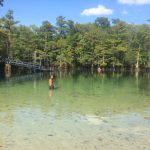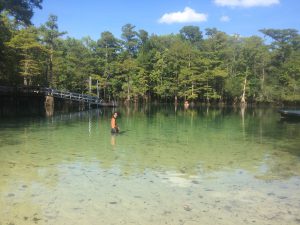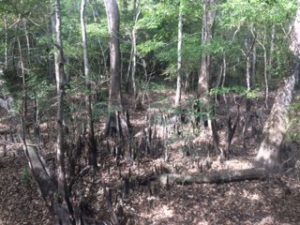
There are over 1000 springs identified in Florida. In the Panhandle, the majority of the springs are karst or artesian springs rising deep from the Floridan Aquafer System within the states limestone base. Springs are unique and can be identified by perennial flows, constant water temperature and chemistry, high light transparency. This yields a freshwater ecology dependent on these features. Springs are classified based upon the average discharge of water but can exhibit a lot of variability based on water withdrawals and rainfall. These springs are some of our most precious water resources, supplying the drinking water our communities rely on, as well as providing great recreation opportunities.
Morrison Springs is a popular spring in northwest Florida and is one of 13 springs flowing into the Choctawhatchee River Basin. It is a large, sandy-bottomed spring surrounded by old growth cypress. The spring pool is 250 feet in diameter, discharges an average of 48 million gallons of water each day from three vents into the Choctawhatchee River as a second magnitude spring. The spring contains an extensive underwater cave system with three cavities up to 300 feet deep and is popular for scuba diving, swimming and snorkeling, kayaking, canoeing and fishing. Historically, it was privately owned and was a popular swimming hole for locals. In 2004, the state of Florida purchased the land containing the spring in the Choctawhatchee River floodplain. The land was leased to Walton County for 99 years. The county created a 161-acre park with a picnic pavilion, restroom facilities and a wheelchair-accessible boardwalk. A down-stream boat ramp provides access to the river away from swimmers and divers. There is no entrance fee.
Morrison Spring is filled with abundant fish and plant life. Fish include largemouth bass, spotted bass, hybrid striped bass, bluegill, sunfish, redbreast sunfish, warmouth, black crappie, striped bass, catfish, alligator gar, bowfin, carp, mullet and flounder or hogchoakers (freshwater sole). It is also home to some nocturnal freshwater eels that swim around the vent and delight the divers. Most are gray, about an inch in diameter and maybe a foot or two long. The spring supports many trees, plants, and grasses including bald cypress, live oak, red maple, pawpaw, red and black titi, Cherokee bean, sweetbay, blackgum, juniper, red cedar, southern magnolia, laurel oak, tupelo, hickory, willow, wax myrtle, cabbage palm, saw palmetto blueberry, hydrangea, St. John’s wort, mountain laurel, water lily, pickerelweed, pitcher plant, broad leaved arrowhead, fern, and moss.
Morrison Springs was previously considered one of the cleanest springs in Florida until 2010 (Florida Springs Initiative). All of Florida springs are currently at risk as the state population continues to increase. Spring flows are decreasing as the result of increasing extraction of groundwater for human uses. Development, and the resultant over pumping, and nitrogen pollution from agriculture both have impacts on the aquifer recharge areas. Existing groundwater pumping rates from the Floridan Aquifer in 2010 were more than 30% of average aquifer recharge (Florida Spring Initiative). The University of Florida IFAS Extension Agents in the Panhandle occasionally conduct interpretive guided tours of the Springs to help citizens understand the importance of protecting this unique water source.
Posted: November 19, 2016
Category: Natural Resources, Recreation
Tags: County, Florida, Morrison, Panhandle Outdoors, Park, Springs, Walton



